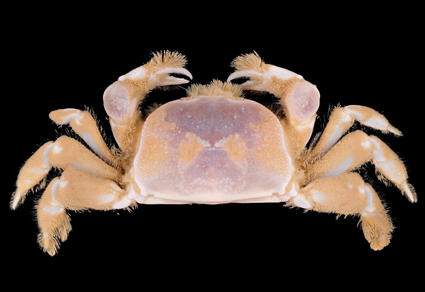Abstract
A new species of hexapodid crab of the genus Hexapinus Manning & Holthuis, 1981 is described based on three females from Okinawa Island, Ryukyu Islands, southwestern Japan. Hexapinus okinawa sp. nov., described in this study, can be distinguished from its closest congener, H. simplex Rahayu & Ng, 2014, by a narrower carapace and setation on the carapace and ambulatory legs. Molecular phylogenetic analyses also support the difference of these two species. In addition, close morphological examination and the molecular phylogeny indicate at least two linages are included within Hexapinus. The polyphyletic nature of Hexapinus and the characteristics of the two lineages are discussed.
References
- Castresana, J. (2002) Selection of conserved blocks from multiple alignments for their use in phylogenetic analysis. Molecular Biology and Evolution, 17, 540–552. https://doi.org/10.1093/oxfordjournals.molbev.a026334
- Colgan, D.J., McLauchlan, A., Wilson, G.D.F., Livingston, S.P., Edgecombe, G.D., Macaranas, J., Cassis, G. & Gray, M.R. (1998) Histone H3 and U2 snRNA DNA sequences and arthropod molecular evolution. Australian Journal of Zoology, 46 (5), 419–437. https://doi.org/10.1071/ZO98048
- Haan, W. de (1833–1849) Crustacea. In: von Siebold, P.F. (Ed.), Fauna Japonica sive Descriptio Animalium, quae in Itinere per Japoniam, Jussu et Auspiciis Superiorum, Qui Summum in India Batava Imperium Tenent, Suscepto, Annis 1823–1830 Collegit, Notis, Observationibus et Adumbrationibus Illustravit, (Crustacea). Lugundi-Batavorum, Leiden, pp. xvii + xxxi + iix–xvi + 1–243, pls. A–J + L–Q + 1–55, circ. tab. 2.
- Hall, T.A. (1999) BioEdit: a user-friendly biological sequence alignment editor and analysis program for Windows 95/98/NT. Nucleic Acids Symposium Series, 41, 95–98.
- Hoang, D.T., Chernomor, O., von Haeseler, A., Minh, B.Q. & Vinh, L.S. (2017) UFBoot2: improving the ultrafast bootstrap approximation. Molecular Biology and Evolution, 35, 518–522. https://doi.org/10.1093/molbev/msx281
- Kalyaanamoorthy, S., Minh, B.Q., Wong, T., von Haeseler, A. & Jermiin, L.S. (2017) ModelFinder: Fast model selection for accurate phylogenetic estimates. Nature Methods, 14, 587–589. https://doi.org/10.1038/nmeth.4285
- Katoh, K., Rozewicki, J. & Yamada, K.D. (2019) MAFFT online service: multiple sequence alignment, interactive sequence choice and visualization. Briefings in Bioinformatics, 20 (4), 1160–1166. https://doi.org/10.1093/bib/bbx108
- Katoh, K. & Toh, H. (2008) Improved accuracy of multiple ncRNA alignment by incorporating structural information into a MAFFT-based framework. BMC Bioinformatics, 9, 212. https://doi.org/10.1186/1471-2105-9-212
- Man, J.G.de (1888) Bericht über die von Herrn Dr. J. Brock im indischen Archipel gesammelten Decapoden und Stomatopoden. Archiv für Naturgeschichte, Berlin, 53 (1), 289–600, pls. 11–22a. https://doi.org/10.5962/bhl.part.4747
- Manning, R.B. & Holthuis, L.B. (1981) West African brachyuran crabs (Crustacea: Decapoda). Smithsonian Contributions to Zoology, 306, 1–379. https://doi.org/10.5479/si.00810282.306
- Miers, E.J. (1886) Part II. Report on the Brachyura collected by H.M.S. “Challenger” during the years 1873–1876. In: Report on the Scientific Result of the Voyage of H.M.S. Challenger during the years 1873–1876 under the command of Captain George S. Nares, N.R., F.R.S. and the late Captain Frank Tourle Thomson, R.N. prepared under the Superintendence of the late Sir C. Wyville Thomsonn, Knt., F.R.S. & Regius Professor of Natural History in the University of Edinburgh of the civilian scientific staff on board and now of John Murray one of the naturalist of the Expedition. Zoology, Published by Order of Her Majesty’s Government. Vol. 17. HMSO, London, Edinburgh and Dublin, pp. i–1 + 1–362, pls. 1–29.
- Naruse, T. (2020) A new species of Hexapinus Manning & Holthuis, 1981 (Decapoda: Brachyura: Hexapodidae) from Hatoma Island, Ryukyu Islands, Japan. Crustacean Research, 49, 49–55. https://doi.org/10.18353/crustacea.49.0_49
- Naruse, T., Watanabe, T. & Yoshida, R. (2017) Additional information on the distribution and habitats of six hexapodid species (Crustacea: Decapoda: Brachyura), with review of their Japanese names. Fauna Ryukyuana, 35, 17–28. [in Japanese with English abstract and figure captions]
- Ng, P.K.L. & Rahayu, D.L. (2015) Notes on Hexapodidae (Crustacea, Brachyura) from Indonesia and Malaysia, with description of a new species of Mariaplax Rahayu & Ng, 2014, from Lombok, Indonesia. Zootaxa, 3981 (1), 125–137. https://doi.org/10.11646/zootaxa.3981.1.7
- Palumbi, S.R. & Benzie, J. (1991) Large mitochondrial DNA differences between morphologically similar Penaeid shrimp. Molecular Marine Biology and Biotechnology, 1, 27–34.
- Rahayu, D.L. & Ng, P.K.L. (2014) New genera and new species of Hexapodidae (Crustacea, Brachyura) from the Indo-West Pacific and east Atlantic. Raffles Bulletin of Zoology, 62, 396–483.
- Rambaut, A. (2018) FigTree. Version 1.4.4. Institute of Evolutionary Biology, University of Edinburgh, Edinburgh. Available from: http://tree.bio.ed.ac.uk/software/figtree/ (accessed 2 May 2024)
- Serène, R. & Soh, C.L. (1976) Brachyura collected during the Thai Danish Expedition (1966). Research Bulletin, Phuket Marine Biological Center, 12, 1–37.
- Sinniger, F., Reimer, J.D. & Pawlowski, J. (2010) The Parazoanthidae (Hexacorallia: Zoantharia) DNA taxonomy: description of two new genera. Marine Biodiversity, 40 (1), 57–70. https://doi.org/10.1007/s12526-009-0034-3
- Svenson, G.J. & Whiting, M.F. (2004) Phylogeny of Mantodea based on molecular data: evolution of a charismatic predator. Systematic Entomology, 29, 359–370. https://doi.org/10.1111/j.0307-6970.2004.00240.x
- Tamura, K., Stecher, G. & Kumar, S. (2021) MEGA 11: Molecular Evolutionary Genetics Analysis Version 11. Molecular Biology and Evolution, 37, 1237–1239. https://doi.org/10.1093/molbev/msab120
- Trifinopoulos, J., Nguyen, L.-T., von Haeseler, A. & Minh, B.Q. (2016) W-IQ-TREE: a fast online phylogenetic tool for maximum likelihood analysis. Nucleic Acids Research, 44 (W1), W232–W235. https://doi.org/10.1093/nar/gkw256


